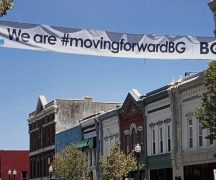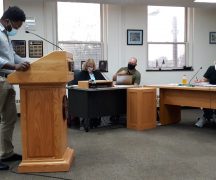By JAN LARSON McLAUGHLIN
BG Independent News
It was the battle between hot dogs and Philly cheese steaks Monday during the first meeting tackling the food truck issue in Bowling Green.
Brick and mortar restaurants and mobile food trucks manage to co-exist in other communities – so Bowling Green is looking for the secret recipe to allow both to operate in this city.
But the common ground for rooted and wheeled restaurants may take awhile to find.
“We’re all in the same boat,” said Aaron Evanoff as he talked about his plan for a hot dog food truck.
“We’re not in the same boat,” Jim Gavarone, owner of Mr. Spots, disagreed from the audience.
The current city ordinance permits food trucks, but requires them on private property with large setbacks in some areas, and only during limited hours. The rules have been found to be too cumbersome, so a City Council committee has been charged with finding a middle ground that can work for citizens, existing brick and mortar restaurants and mobile vendors.
Monday was the first meeting of the Public Lands and Buildings Committee, made up of council members Bill Herald, Sandy Rowland and John Zanfardino. The committee will meet again on Saturday for a “really good roll up your sleeves working session” from 8 to 11 a.m., in the council chambers.
Zanfardino said many more meetings will have to be held before recommendations can be made to council.
“I’m hoping we can have it done sooner rather than later,” Herald said. “But not so quick that we stifle public input.”
“It’s very important that we get public input. You don’t want to leave it up to us,” Herald said.
The committee will study actions that would allow food trucks to operate, while benefiting the public , promoting entrepreneurship, adding to a strong downtown, and enhancing citizens’ experiences. The group will look for a balance that will not hurt existing restaurants and maintain a vibrant downtown.
Rowland talked about the success that cities like Perrysburg and Toledo have experienced with food trucks. She added that Bowling Green Planning Director Heather Sayler has visited other college towns, like Kent and Oxford, to explore their food truck regulations.
The primary locations in Bowling Green for mobile food vendors are likely the downtown, areas close to the BGSU campus, and the city parks. But the committee first needs to hear from the stakeholders – restaurant owners, food truck operators and citizens.
“I agree on the need for public input,” Rowland said.
Evanoff, who first presented his idea for High Flying Hotdogs to City Council last year, said the city needs to bring its mobile food vending ordinance into a new era. There are many examples of food truck and restaurant owners pleasantly co-habitating, he said. There are ways to make sure mobile vendors don’t crowd the downtown and harm local businesses, he added.
“A lot of perceived negatives frankly are not there,” Evanoff said.
Overly strict regulations kill mobile food businesses before they even begin, he said. Evanoff suggested the city strike a balance and not use blanket regulations that will discourage food trucks.
Though Rowland sees the need for regulations, she understood Evanoff’s desire for the same brick and mortar rules to apply to his business. And the same food regulations would be imposed by the Wood County Health District.
“Food vendors are entrepreneurial. They are just getting a start. They want to fill a void,” she said.
But Gavarone, who opened Mr. Spots 32 years ago, said the city’s restaurant owners don’t need more competition.
“I decided to stay in this community and build my business,” including a recent renovation of his North Main location.
“To this day, we’re still operating on some very thin margins,” he said. “I don’t know anyone who thinks we need more bars and restaurants downtown.”
Mary Hinkelman, representing Downtown BG, said the change in food truck rules has some downtown businesses feeling “a little bit of fear.”
The downtown has 27 food establishments, which have made investments in their buildings and commitments to the community, she said.
One of the primary concerns for downtown businesses is the additional trash that food trucks will leave behind.
“We already have a daunting task cleaning up after the nightlife in Bowling Green,” Hinkelman said.
Rowland responded that research of other communities with food trucks has shown that trash can be handled successfully.
Both Hinkelman and Gavarone also said that all is not rosy with the food trucks in Perrysburg.
“I do know there was a flap up in Perrysburg,” Gavarone said.
“As businesses, they aren’t enthusiastic about the competition,” Hinkelman said of the brick and mortar stores.





